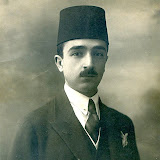THIS IS NOT A HAT
The fez in photographs
“In Bulgaria you still see the local Turkish peasants working in the fields in the Turkish traditional costume – the red fez with the embroidered yellow scarf wound round it – and it is curious, when you enter Turkey, to see this familiar figure of the Turk, as you know him, suddenly disappear from the landscape.”
Arnold Toynbee; A Journey to China, or Things Which Are Seen, 1931
On November 25, 1925, Kemal Ataturk, first President of the two year old Republic of Turkey, delivered a speech in the small town of Kastamonu with far reaching effects. “This is a hat,” he said, holding up a Homburg. “It has a brim.” From now on, wearing the fez was outlawed. His reasons for prohibiting an internationally recognized symbol of Turkey had to do with its historical connotations, though whether as some people say he saw it as a symbol of submission to Islam or more a very obvious artifact of the Ottoman Empire isn’t clear. It could have been both. There is a story that as a young attaché in Paris, Ataturk was approached by a French official who pointed to his fez and asked why he wore such a ridiculous accoutrement. That sounds suspiciously apocryphal; as though Ataturk carried the official’s words in his heart for years when he would have heard far more stinging insults directed against his decaying nation.
Like the burqa, the fez is implicitly associated with Islam and variations on its design are found from Morocco to Indonesia though it is most strongly identified with Ottoman Turkey and Egypt. There is some dispute as to its origins, with some scholars pointing to the Balkans, but the hat as we know it really began its life in 1829, when Sultan Mehmed II decreed that it become part of a civil servant’s uniform. One reason given for the decline of the Ottoman Empire was its absurdly over managed bureaucracy, which meant – among other things – that in Constantinople close to half the men wore fezzes. That is also why, despite its religious significance, Armenians, Greeks and Jews appear in photographs wearing the fez. It identified them as respectable members of the middle class; in the same way the black bowler hat became a symbol of the professional classes in England.
As hats go, the fez is supremely non-functional. It does not protect the wearer from the sun or keep him warm but Ataturk may have overlooked something Mehmed II realized. A man in a fez looks dignified and urbane. This isn’t simply the effect of looking back on the past from a safe distance. Something about its elemental design added gravitas in ways denied to more elaborate headwear. The top hat for example really needed an overcoat and ideally a cane to mark its wearer as a man about town. The fez needs nothing more than a jacket.
Ataturk might not have realized this either; as far as Hollywood was concerned, the fez came to represent something a fair distance from religion, piety anyway. Think of any film from the 1920s onwards that featured a Middle Eastern type wearing a fez. Always sinister yet undeniably elegant, he was the one who knew the secrets and just what was at stake for the naïve American or British hero. The most famous wearer of the fez in Hollywood was Boris Karloff in The Mummy; 3000 years old and filled with the wisdom of the ages. Glancing through a list of other Hollywood actors in roles that required a fez – Sidney Greenstreet in Casablanca, Victor Mature in something called The Shanghai Gesture (“People Live in Shanghai for Many Reasons... Most of Them Bad!”) – we see that they were inevitably on the wrong side of the law, either swarthy Middle Eastern types who dabbled in crime or Westerners who’d fled south and embraced dissipation. You didn’t need much in the way of character development when a simple fez said it all.
In a way that still holds true. It is all we require to understand an image in the context of time and place and it can turn an otherwise straightforward portrait into something exotic and mysterious. In Turkey, the fez may have gone the way of plus fours, the corset and the tricorn, a fashion item no one sees any good reason to resuscitate, but it still exerts a strange power, a key to the intangible heritage of cultural identity.
 |
| THIS IS NOT A HAT |





No comments:
Post a Comment
Add comments here